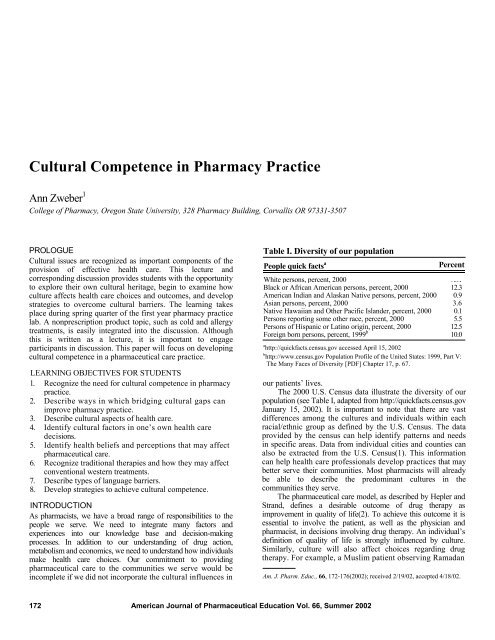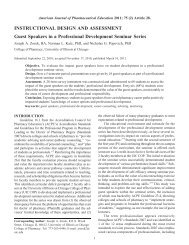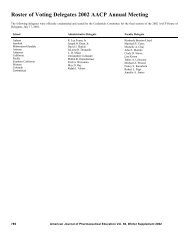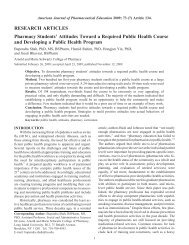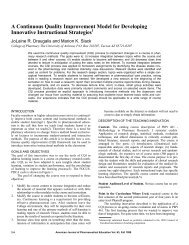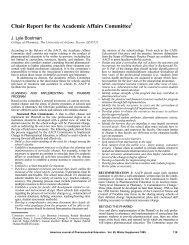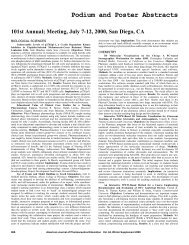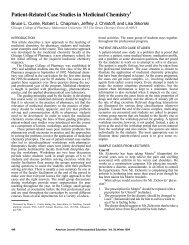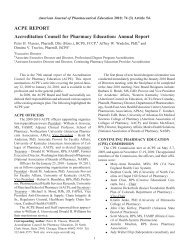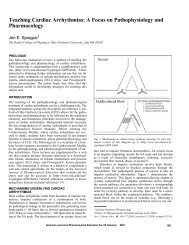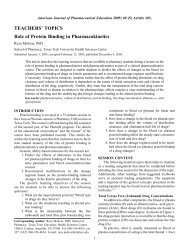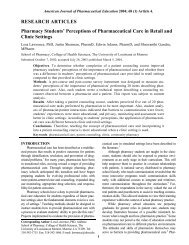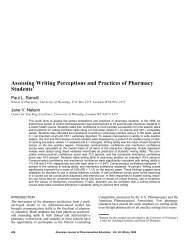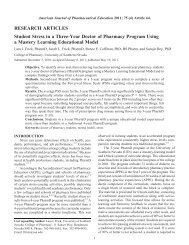Cultural Competence in Pharmacy Practice.pdf - pharmacy304
Cultural Competence in Pharmacy Practice.pdf - pharmacy304
Cultural Competence in Pharmacy Practice.pdf - pharmacy304
You also want an ePaper? Increase the reach of your titles
YUMPU automatically turns print PDFs into web optimized ePapers that Google loves.
<strong>Cultural</strong> <strong>Competence</strong> <strong>in</strong> <strong>Pharmacy</strong> <strong>Practice</strong><br />
Ann Zweber 1<br />
College of <strong>Pharmacy</strong>, Oregon State University, 328 <strong>Pharmacy</strong> Build<strong>in</strong>g, Corvallis OR 97331-3507<br />
PROLOGUE<br />
<strong>Cultural</strong> issues are recognized as important components of the<br />
provision of effective health care. This lecture and<br />
correspond<strong>in</strong>g discussion provides students with the opportunity<br />
to explore their own cultural heritage, beg<strong>in</strong> to exam<strong>in</strong>e how<br />
culture affects health care choices and outcomes, and develop<br />
strategies to overcome cultural barriers. The learn<strong>in</strong>g takes<br />
place dur<strong>in</strong>g spr<strong>in</strong>g quarter of the first year pharmacy practice<br />
lab. A nonprescription product topic, such as cold and allergy<br />
treatments, is easily <strong>in</strong>tegrated <strong>in</strong>to the discussion. Although<br />
this is written as a lecture, it is important to engage<br />
participants <strong>in</strong> discussion. This paper will focus on develop<strong>in</strong>g<br />
cultural competence <strong>in</strong> a pharmaceutical care practice.<br />
LEARNING OBJECTIVES FOR STUDENTS<br />
1. Recognize the need for cultural competence <strong>in</strong> pharmacy<br />
practice.<br />
2. Describe ways <strong>in</strong> which bridg<strong>in</strong>g cultural gaps can<br />
improve pharmacy practice.<br />
3. Describe cultural aspects of health care.<br />
4. Identify cultural factors <strong>in</strong> one’s own health care<br />
decisions.<br />
5. Identify health beliefs and perceptions that may affect<br />
pharmaceutical care.<br />
6. Recognize traditional therapies and how they may affect<br />
conventional western treatments.<br />
7. Describe types of language barriers.<br />
8. Develop strategies to achieve cultural competence.<br />
INTRODUCTION<br />
As pharmacists, we have a broad range of responsibilities to the<br />
people we serve. We need to <strong>in</strong>tegrate many factors and<br />
experiences <strong>in</strong>to our knowledge base and decision-mak<strong>in</strong>g<br />
processes. In addition to our understand<strong>in</strong>g of drug action,<br />
metabolism and economics, we need to understand how <strong>in</strong>dividuals<br />
make health care choices. Our commitment to provid<strong>in</strong>g<br />
pharmaceutical care to the communities we serve would be<br />
<strong>in</strong>complete if we did not <strong>in</strong>corporate the cultural <strong>in</strong>fluences <strong>in</strong><br />
Table I. Diversity of our population<br />
People quick facts a<br />
Percent<br />
White persons, percent, 2000 75.1<br />
Black or African American persons, percent, 2000 12.3<br />
American Indian and Alaskan Native persons, percent, 2000 0.9<br />
Asian persons, percent, 2000 3.6<br />
Native Hawaiian and Other Pacific Islander, percent, 2000 0.1<br />
Persons report<strong>in</strong>g some other race, percent, 2000 5.5<br />
Persons of Hispanic or Lat<strong>in</strong>o orig<strong>in</strong>, percent, 2000 12.5<br />
Foreign born persons, percent, 1999 b 10.0<br />
a http://quickfacts.census.gov accessed April 15, 2002<br />
b http://www.census.gov Population Profile of the United States: 1999, Part V:<br />
The Many Faces of Diversity [PDF] Chapter 17, p. 67.<br />
our patients’ lives.<br />
The 2000 U.S. Census data illustrate the diversity of our<br />
population (see Table I, adapted from http://quickfacts.census.gov<br />
January 15, 2002). It is important to note that there are vast<br />
differences among the cultures and <strong>in</strong>dividuals with<strong>in</strong> each<br />
racial/ethnic group as def<strong>in</strong>ed by the U.S. Census. The data<br />
provided by the census can help identify patterns and needs<br />
<strong>in</strong> specific areas. Data from <strong>in</strong>dividual cities and counties can<br />
also be extracted from the U.S. Census(1). This <strong>in</strong>formation<br />
can help health care professionals develop practices that may<br />
better serve their communities. Most pharmacists will already<br />
be able to describe the predom<strong>in</strong>ant cultures <strong>in</strong> the<br />
communities they serve.<br />
The pharmaceutical care model, as described by Hepler and<br />
Strand, def<strong>in</strong>es a desirable outcome of drug therapy as<br />
improvement <strong>in</strong> quality of life(2). To achieve this outcome it is<br />
essential to <strong>in</strong>volve the patient, as well as the physician and<br />
pharmacist, <strong>in</strong> decisions <strong>in</strong>volv<strong>in</strong>g drug therapy. An <strong>in</strong>dividual’s<br />
def<strong>in</strong>ition of quality of life is strongly <strong>in</strong>fluenced by culture.<br />
Similarly, culture will also affect choices regard<strong>in</strong>g drug<br />
therapy. For example, a Muslim patient observ<strong>in</strong>g Ramadan<br />
Am. J. Pharm. Educ., 66, 172-176(2002); received 2/19/02, accepted 4/18/02.<br />
172 American Journal of Pharmaceutical Education Vol. 66, Summer 2002
Table II. Percent differences <strong>in</strong> education, family structure and <strong>in</strong>come levels a<br />
Race/ethnicity<br />
High school<br />
Diploma (1999)<br />
Poverty rate<br />
(1998)<br />
Households ma<strong>in</strong>ta<strong>in</strong>ed by<br />
married couples (1999)<br />
White, non-Hispanic 87.7 8 82.2<br />
Black 77.0 26 47.1<br />
Asian and Pacific Islander 84.6 13 79.9<br />
Hispanic (of any race) 56.1 26 68.0<br />
Foreign-born persons 66 18 Not available<br />
a From http://www.census.gov Population Profile of the United States: 1999, Part V: The Many Faces of Diversity [PDF] Chapter 16, pp. 64-66.<br />
Table III. Health Differences between ethnic groups a<br />
Percent with<strong>in</strong> ethnic group<br />
Race/ethnicity Type II Diabetes Flu vacc<strong>in</strong>ation rate b Cigarette smok<strong>in</strong>g c<br />
White, non-Hispanic<br />
(45-64 y.o.)<br />
Black, non-Hispanic<br />
(40-74 y.o.)<br />
Asian and Pacific Islander<br />
Hispanic<br />
(>50 y.o.)<br />
Native American<br />
(45-74 y.o.)<br />
5.2 69.0 24.3<br />
18.2 48.1 24.3<br />
N/A<br />
20-30<br />
N/A<br />
58.6<br />
15.1<br />
18.1<br />
40-70 N/A 40.8<br />
a NIDDK Centers for Disease Control and Prevention, http://www.niddk.nih.gov Accessed January 15, 2002.<br />
b Aged over 65 years who reported U.S. 1999 MMWR June 29, 2001.<br />
c Aged over 18 years who were current smokers, National Health Interview Survey- US 1999, MMWR October 12, 2001.<br />
may not be able to take erythromyc<strong>in</strong> three times daily with<br />
food. If she attempts to take the medication dur<strong>in</strong>g the daytime<br />
(<strong>in</strong> which she is fast<strong>in</strong>g) she may suffer nausea and vomit<strong>in</strong>g<br />
commonly associated with tak<strong>in</strong>g erythromyc<strong>in</strong> on an empty<br />
stomach, and fail to complete treatment. To fully achieve the<br />
goals described <strong>in</strong> this mission, a pharmacist must <strong>in</strong>corporate<br />
a variety of patient factors, <strong>in</strong>clud<strong>in</strong>g personal and cultural<br />
<strong>in</strong>fluences on health care decisions.<br />
Anne Fadiman’s book, The Spirit Catches You and You<br />
Fall Down, reveals the tragic story of how our advanced<br />
health care system did not meet the needs of a Hmong child.<br />
In this factual account, a Hmong child with a seizure disorder<br />
failed to receive effective treatment not only because of<br />
language barriers, but also because of a lack of understand<strong>in</strong>g<br />
of the cultural <strong>in</strong>fluences on treat<strong>in</strong>g such disorders. The<br />
Hmong family perceived the disorder as “a gift which<br />
qualified her to be a shaman.” In addition, the family<br />
employed traditional remedies and treatment strategies of<br />
which the physicians were unaware(3). The award-w<strong>in</strong>n<strong>in</strong>g<br />
book makes a strong case for the need for cultural competence<br />
<strong>in</strong> the health care system.<br />
In community pharmacy cultural barriers can occur from<br />
both a pharmacist’s and a patient’s perspective. Pharmacists<br />
are often frustrated with counsel<strong>in</strong>g non-English speak<strong>in</strong>g<br />
patients. The development of a more welcome environment,<br />
one that recognizes cultural needs and preferences of<br />
<strong>in</strong>dividuals, br<strong>in</strong>gs the potential for generat<strong>in</strong>g bus<strong>in</strong>ess.<br />
Market<strong>in</strong>g strategies throughout the Unites States have evolved<br />
to target specific ethnic and cultural groups <strong>in</strong> an effort to<br />
<strong>in</strong>crease awareness of products and services. In a community<br />
pharmacy it makes sense to develop ways to make a pharmacy<br />
<strong>in</strong>vit<strong>in</strong>g and comfortable for the communities you serve.<br />
HEALTH DISPARITIES<br />
Data provided by the U.S. Census illustrate disparities <strong>in</strong> education<br />
cation, family structure, and <strong>in</strong>come levels among various<br />
groups. Table II illustrates some examples. Although it is vital<br />
to avoid mak<strong>in</strong>g generalizations, it can be useful to consider<br />
the impact of these factors.<br />
In addition to the disparities noted above, many studies<br />
have identified specific health differences between ethnic<br />
groups. Table III, compiled from various sources, illustrates<br />
some dramatic differences <strong>in</strong> health conditions and behaviors<br />
<strong>in</strong> which pharmacists play an important role. When address<strong>in</strong>g<br />
health care issues like those listed, it is essential to consider an<br />
<strong>in</strong>dividual’s health beliefs and cultural <strong>in</strong>fluences.<br />
Prevalence of other health conditions also varies between<br />
ethnic groups. The Department of Health and Human Services<br />
has issued a National Health Promotion and Disease<br />
Prevention objective entitled Healthy People 2010. The goal of<br />
this directive is to elim<strong>in</strong>ate identified health disparities among<br />
ethnic groups. Ten health <strong>in</strong>dicators identified are physical<br />
activity, overweight and obesity, tobacco use, substance abuse,<br />
responsible sexual behavior, mental health, <strong>in</strong>jury and<br />
violence, environmental quality, and access to health care(4).<br />
National Standards for <strong>Cultural</strong>ly and L<strong>in</strong>guistically<br />
Appropriate Services (CLAS) <strong>in</strong> Health Care have been<br />
published by the Department of Health and Human Services<br />
Office of M<strong>in</strong>ority Health and Resources for Cross <strong>Cultural</strong><br />
Health Care(5).<br />
Recogniz<strong>in</strong>g and understand<strong>in</strong>g exist<strong>in</strong>g disparities<br />
encourages pharmacists to th<strong>in</strong>k about ways to overcome<br />
them. How can a pharmacy environment and programs be<br />
changed to improve health care for the communities served?<br />
What communication barriers need to be overcome to ensure that<br />
pharmaceutical care is provided effectively and <strong>in</strong>discrim<strong>in</strong>ately?<br />
What other health care issues and practices need to be <strong>in</strong>cluded<br />
when develop<strong>in</strong>g a care plan for an <strong>in</strong>dividual?<br />
American Journal of Pharmaceutical Education Vol. 66, Summer 2002 173
IDENTIFYING CULTURAL ASPECTS OF HEALTH<br />
CARE<br />
Exam<strong>in</strong><strong>in</strong>g One’s <strong>Cultural</strong> Background<br />
When develop<strong>in</strong>g cultural competence, it is essential to<br />
beg<strong>in</strong> by exam<strong>in</strong><strong>in</strong>g one’s own cultural background. In her<br />
book, <strong>Cultural</strong> Diversity <strong>in</strong> Health and Illness, R. Spector lists<br />
some questions to consider to better understand one’s cultural<br />
heritage and its effects on health care perceptions(6). The<br />
questions below <strong>in</strong>clude many from Spectors work, as well as<br />
some more general cultural background questions.<br />
1. What is your cultural heritage?<br />
2. Where did your parents/grandparents/great grandparents<br />
come from?<br />
3. What were/are some foods, celebrations, rituals, cloth<strong>in</strong>g,<br />
etc that were mean<strong>in</strong>gful to your family and symbolized<br />
your cultural background?<br />
4. “How do you def<strong>in</strong>e health?”<br />
5. “How do you keep yourself healthy?”<br />
6. “How do you def<strong>in</strong>e illness?” What causes illness?<br />
7. “What would you def<strong>in</strong>e as a m<strong>in</strong>or, or non-serious<br />
medical problem?”<br />
8. “How do you know when a given health problem does not<br />
need medical attention?”<br />
9. What health problems do you self-diagnose?<br />
10. Who do you seek for help with m<strong>in</strong>or health problems?<br />
Major health problems?<br />
11. “Do you use over the counter medications? Which ones<br />
and when?”<br />
12. Who makes health care decisions <strong>in</strong> your family?<br />
13. What expectations are there for who is to care for an<br />
elderly relative?<br />
Giv<strong>in</strong>g some thought to the questions above facilitates<br />
understand<strong>in</strong>g of cultural <strong>in</strong>fluences. Bonder, et al., describe<br />
culture as be<strong>in</strong>g learned, localized, patterned, evaluative, and<br />
hav<strong>in</strong>g cont<strong>in</strong>uity(7). By recogniz<strong>in</strong>g the impact of culture on<br />
behaviors, perceptions, and choices, one can more readily<br />
identify and accept others’ cultural <strong>in</strong>fluences.<br />
To avoid mak<strong>in</strong>g <strong>in</strong>accurate generalizations about an<br />
<strong>in</strong>dividual’s culture, consider the culturally supported<br />
boundaries with<strong>in</strong> which an <strong>in</strong>dividual makes choices. Open<br />
discussion with a client about health care beliefs will be the<br />
most useful approach to <strong>in</strong>clude cultural <strong>in</strong>fluences <strong>in</strong> health<br />
care strategies. In order to better understand how an<br />
<strong>in</strong>dividual’s cultural background will affect pharmaceutical<br />
care, three general areas will be considered: (i) health care<br />
perspectives and beliefs; (ii) traditional medic<strong>in</strong>es and<br />
therapies; (iii) communication patterns.<br />
Health Perception and Treatment Choices<br />
The role of social structure and family members can<br />
strongly <strong>in</strong>fluence one’s health care choices. Be<strong>in</strong>g aware of<br />
family members’ traditional roles <strong>in</strong> health care decisionmak<strong>in</strong>g<br />
can help us recognize patterns and prevent potential<br />
conflicts. For example, <strong>in</strong> a some Hispanic families the<br />
grandmother or mother is responsible for mak<strong>in</strong>g health care<br />
decisions, whereas the father may be responsible for most<br />
other decisions. In some Southeast Asian cultures the oldest<br />
male <strong>in</strong> the family makes health care decisions(8).<br />
Most cultures embrace a standard protocol for treatment<br />
of illnesses. The severity of the illness generally dictates who<br />
is sought for treatment. Oftentimes an elder family member is<br />
consulted for m<strong>in</strong>or illnesses. Once a condition progresses,<br />
however, approaches to treatment diverge among cultures. For<br />
many people with strong religious beliefs, a priest or church<br />
leader may be consulted at any stage <strong>in</strong> an illness. Prayer may<br />
be an important part of the heal<strong>in</strong>g process, or an essential<br />
element of health ma<strong>in</strong>tenance(9). Recent immigrants, such as<br />
those <strong>in</strong> the Ethiopian community, may be unaccustomed to<br />
the United States health system, and seek the advice and<br />
expertise of a tribal healer or a community member with a<br />
reputation for heal<strong>in</strong>g(8).<br />
As with conventional medic<strong>in</strong>e, the treatment sought will<br />
correspond with what the patient perceives as the cause of the<br />
illness. The patient who th<strong>in</strong>ks an illness has been caused by a<br />
curse or spell may beg<strong>in</strong> treatment with prayer, or by seek<strong>in</strong>g<br />
advice from a spiritualist or traditional healer(8). In some<br />
cases treatment may not be sought at all because the condition<br />
is considered shameful. For example, mental illness can be<br />
considered disgraceful <strong>in</strong> Vietnamese culture, and a patient may<br />
be reluctant to acknowledge and seek treatment for such<br />
problems(10). Allow<strong>in</strong>g the client to discuss his beliefs about an<br />
illness <strong>in</strong> a non-threaten<strong>in</strong>g environment will allow <strong>in</strong>corporation<br />
of his beliefs and practices <strong>in</strong> to a reasonable and collaborative<br />
care plan.<br />
Traditional Medic<strong>in</strong>e and Therapies<br />
As pharmacists we are especially concerned with<br />
alternative treatments that patients are us<strong>in</strong>g. In a multicultural<br />
population we face even more challenges with a patient’s use<br />
of home remedies that may <strong>in</strong>clude herbs and foods as well as<br />
traditional heal<strong>in</strong>g therapies and rituals. In addition, a patient’s<br />
perception of prescribed Western medic<strong>in</strong>es may also<br />
<strong>in</strong>fluence his commitment to treatment.<br />
It has become commonplace to ask patients about<br />
nonprescription and alternative medic<strong>in</strong>e use. We have come to<br />
recognize commonly used herbal remedies, and can often<br />
screen for potential <strong>in</strong>teractions or problems before they arise.<br />
When elicit<strong>in</strong>g home remedies or less common herbal<br />
treatments used by some patients, it may be difficult to assess<br />
their role <strong>in</strong> therapy. Many Asian people have a vast array of<br />
herbal remedies available to them from their herbalist,<br />
traditional Ch<strong>in</strong>ese pharmacist, or brought directly from their<br />
homeland. Often the patient is unable to provide the practitioner<br />
with an accurate description or English name of the herb or<br />
mixture. Under these circumstances it is important to gather as<br />
much <strong>in</strong>formation as possible about the herb’s <strong>in</strong>tended use, its<br />
possible action, and potential adverse effects and drug<br />
<strong>in</strong>teractions. If a real potential for <strong>in</strong>teraction or adverse effects<br />
exists, the practitioner may need to conv<strong>in</strong>ce the patient to<br />
discont<strong>in</strong>ue the herbal remedy for a period of time.<br />
Pharmacists may be less concerned with traditional<br />
therapies that do not <strong>in</strong>clude foods or herbs, but they need to<br />
be acknowledged nonetheless. Acupuncture, co<strong>in</strong><strong>in</strong>g, prayer,<br />
and voodoo may not have potential for drug <strong>in</strong>teractions;<br />
however, be<strong>in</strong>g aware of a patient’s practices and preferences<br />
can improve overall understand<strong>in</strong>g of his health care (10).<br />
Some practices such as co<strong>in</strong><strong>in</strong>g may leave marks, which may<br />
be mis<strong>in</strong>terpreted if a practitioner is not aware of their orig<strong>in</strong>.<br />
If the alternative treatment poses no harm to the <strong>in</strong>dividual, it<br />
may be <strong>in</strong>tegrated with conventional therapies to allow the<br />
patient some control and <strong>in</strong>crease acceptance of nontraditional<br />
treatment.<br />
Many cultures perceive a balance of hot and cold to be a<br />
key component of health ma<strong>in</strong>tenance. In this scheme, some<br />
174 American Journal of Pharmaceutical Education Vol. 66, Summer 2002
illnesses are considered “hot” and need to be treated with<br />
“cold” remedies or treatments. Conversely, a “cold” illness<br />
should be treated with a “hot” medic<strong>in</strong>e. This concept follows<br />
the y<strong>in</strong>/yang model commonly found <strong>in</strong> Asian cultures, and<br />
many Hispanic cultures adhere to similar beliefs. For example,<br />
some Hispanic people may consider penicill<strong>in</strong> a “hot”<br />
medic<strong>in</strong>e, and may not be will<strong>in</strong>g to use it if prescribed for a<br />
condition the patient perceives as hav<strong>in</strong>g “hot” symptoms,<br />
such as a fever (8).<br />
Communication<br />
Perhaps the most common, yet least recognized,<br />
communication barrier is that between medical professionals<br />
and lay people. As we are educated and acculturated <strong>in</strong>to the<br />
medical profession, we spend a substantial amount of time<br />
with others who have similar <strong>in</strong>terests, educational level, and<br />
specialized language. Terms such as G.I., anti-<strong>in</strong>flammatory,<br />
b.i.d., hypopigmentation, and range of motion become a part<br />
of our “everyday” language, often to the detriment of our<br />
patients. As pharmacists we frequently hear patients<br />
express<strong>in</strong>g their frustration with not be<strong>in</strong>g able to understand<br />
what the doctor just told them. Yet pharmacists often fall <strong>in</strong>to<br />
the same trap. Pay<strong>in</strong>g attention to the “language” we use when<br />
speak<strong>in</strong>g with patients is a first step to bridg<strong>in</strong>g<br />
communication barriers(11).<br />
The non-English speak<strong>in</strong>g patient more obviously presents<br />
cross-cultural communication problems. New directives, such<br />
as those outl<strong>in</strong>ed <strong>in</strong> Healthy People 2010, have been enacted to<br />
help dim<strong>in</strong>ish this source of potential health disparities.<br />
Although many hospitals are able to hire <strong>in</strong>terpreters or<br />
bil<strong>in</strong>gual personnel, this may not be a practical solution for<br />
smaller community pharmacies. Oftentimes a child of a non-<br />
English speak<strong>in</strong>g patient is enlisted to translate. This can lead to<br />
further difficulties if the condition is of a personal nature or if<br />
the child cannot translate accurately. Written materials are often<br />
used <strong>in</strong> an attempt to overcome a spoken language barrier,<br />
however the possibility of illiteracy should be considered.<br />
Pictograms, like those found <strong>in</strong> the USPDI, can be used to some<br />
extent to convey basic messages. Simple draw<strong>in</strong>gs and<br />
demonstrations may also be useful to convey messages.<br />
Expect<strong>in</strong>g pharmacists to become fluent <strong>in</strong> all the<br />
languages of the clients they serve is impractical. However, it<br />
may be useful to learn simple phrases <strong>in</strong> languages of non-<br />
English speak<strong>in</strong>g clients who commonly visit the pharmacy.<br />
Learn<strong>in</strong>g how to say a typical greet<strong>in</strong>g demonstrates <strong>in</strong>terest <strong>in</strong><br />
improv<strong>in</strong>g communication and learn<strong>in</strong>g about your clients.<br />
Even when the phrase is not uttered properly, most clients<br />
appreciate the effort as a genu<strong>in</strong>e <strong>in</strong>terest <strong>in</strong> their culture.<br />
Learn<strong>in</strong>g other phrases such as, “I don’t understand” or “speak<br />
slower please” can be very useful. F<strong>in</strong>ally, know<strong>in</strong>g about<br />
resources available for your clients can help with referrals.<br />
Many communities have <strong>in</strong>terpreters, cultural centers, and<br />
English <strong>in</strong>struction classes.<br />
Nonverbal communication practices are another barrier to<br />
effective communication. Behavioral scientists have found that<br />
55-95 percent of a message communicated may be nonverbal<br />
(12, 13). Aspects to consider <strong>in</strong> nonverbal communication are<br />
eye contact, personal space and touch, and facial expression.<br />
Anglo Americans typically perceive eye contact as an<br />
expression of <strong>in</strong>terest and sign of honesty. In many Middle<br />
Eastern and Asian cultures, however, eye contact is considered<br />
a sign of disrespect. Be<strong>in</strong>g aware of cultural <strong>in</strong>fluences on eye<br />
contact can help a health care provider avoid judgment about a<br />
client’s character.<br />
Comfortable personal space varies among cultures. Anglo<br />
American patients may desire a wider circle of personal space,<br />
and touch, however s<strong>in</strong>cere the <strong>in</strong>tention, may be unwelcome.<br />
It is also important to note that there may be strong gender<br />
taboos for touch and space. A Japanese woman may reach out<br />
to a female pharmacist, but shy away from her male colleague.<br />
In contrast, for many African Americans touch is an essential<br />
part of health care, and personal space is m<strong>in</strong>imal by<br />
comparison(13). A client may provide clues about her cultural<br />
perceptions of space and touch. If she stands close, or reaches<br />
out to touch the pharmacist, consider cultural <strong>in</strong>fluences <strong>in</strong> her<br />
nonverbal communication. It is not necessary, however, to<br />
abandon one’s own comfort zones to accommodate a client.<br />
Simply understand<strong>in</strong>g the context of another’s communication<br />
style can help m<strong>in</strong>imize misconceptions. If language is not a<br />
problem, space and touch issues can be addressed with honest<br />
and direct dialogue. Simply stat<strong>in</strong>g, “I am not comfortable<br />
be<strong>in</strong>g so close,” or ask<strong>in</strong>g, “Is it okay if I touch your arm?”<br />
can prevent misunderstand<strong>in</strong>gs.<br />
Facial expressions have the potential for be<strong>in</strong>g<br />
mislead<strong>in</strong>g. Nodd<strong>in</strong>g and say<strong>in</strong>g yes may seem an <strong>in</strong>dication<br />
of understand<strong>in</strong>g; however, <strong>in</strong> some Southeast Asian cultures<br />
it simply <strong>in</strong>dicates the person is pay<strong>in</strong>g attention and be<strong>in</strong>g<br />
polite(l0). Request<strong>in</strong>g that the patient demonstrate<br />
understand<strong>in</strong>g by repeat<strong>in</strong>g what has been told can ensure that<br />
the correct message has been received.<br />
Achiev<strong>in</strong>g <strong>Cultural</strong> <strong>Competence</strong><br />
<strong>Cultural</strong> competence <strong>in</strong> health care requires proper<br />
knowledge, attitude, and skills. One def<strong>in</strong>ition describes it as<br />
be<strong>in</strong>g “able to recognize differences, identify similar patterns<br />
of responses, avoid stereotyp<strong>in</strong>g by acknowledg<strong>in</strong>g variations,<br />
and balance his or her own car<strong>in</strong>g actions by recogniz<strong>in</strong>g<br />
differences and avoid<strong>in</strong>g stereotyp<strong>in</strong>g”(14).<br />
Build<strong>in</strong>g knowledge about the cultures served <strong>in</strong> a<br />
practice sett<strong>in</strong>g is essential for provid<strong>in</strong>g culturally competent<br />
care. There are a number of resources available on the web<br />
and <strong>in</strong> pr<strong>in</strong>t that provide health-related <strong>in</strong>formation about<br />
specific cultures. Appendix A lists some of these resources.<br />
Another approach to understand<strong>in</strong>g family and social structure<br />
<strong>in</strong> cultures is to read literature about the cultures(15).<br />
Anthologies of short stories by authors of specific ethnic<br />
backgrounds are available at most book stores and libraries.<br />
Local resources and cultural centers can also provide<br />
<strong>in</strong>formation about your patients’ culture. Perhaps the best<br />
place to start, however, is to engage <strong>in</strong> open conversation with<br />
patients about their culture and health care beliefs.<br />
After exam<strong>in</strong><strong>in</strong>g one’s own cultural <strong>in</strong>fluences it is easy<br />
to see how health care perceptions and beliefs vary between<br />
<strong>in</strong>dividuals. Recogniz<strong>in</strong>g cultural components of health care<br />
decision mak<strong>in</strong>g, and reserv<strong>in</strong>g judgment, will allow providers<br />
to <strong>in</strong>corporate these factors <strong>in</strong>to patient specific care plans. A<br />
s<strong>in</strong>cere and respectful discussion about another’s health<br />
perceptions can develop a sense of trust between patient and<br />
provider.<br />
Many strategies for atta<strong>in</strong><strong>in</strong>g cultural competency have<br />
been developed and described. The list below summarizes<br />
concepts and practices that can improve cultural competence<br />
<strong>in</strong> pharmacy practice.<br />
1. Exam<strong>in</strong>e your own cultural background.<br />
2. Learn about the cultures you serve.<br />
3. Demonstrate s<strong>in</strong>cere <strong>in</strong>terest <strong>in</strong> your client’s culture. Ask<br />
open-ended questions.<br />
American Journal of Pharmaceutical Education Vol. 66, Summer 2002 175
4. Recognize cultural differences.<br />
5. Don’t generalize or stereotype. Determ<strong>in</strong>e <strong>in</strong>dividual<br />
perceptions, beliefs, preferences, and needs.<br />
6. Make the pharmacy environment welcom<strong>in</strong>g and<br />
attractive based on clients’ cultural backgrounds.<br />
7. Negotiate and educate to develop therapeutic plans<br />
whichare compatible with cultural beliefs.<br />
8. Use culturally sensitive educational approaches and<br />
materials.<br />
9. Learn some phrases of the predom<strong>in</strong>ant non-English<br />
speak<strong>in</strong>g population <strong>in</strong> your community.<br />
10. Be aware of culturally based resources <strong>in</strong> your community.<br />
Have materials available for referral if needed.<br />
11. For language barriers, use a tra<strong>in</strong>ed <strong>in</strong>terpreter if possible.<br />
If not, a family member may be helpful.<br />
12. Pictograms may help convey some messages.<br />
CONCLUSION<br />
Understand that cultural competency is an evolv<strong>in</strong>g process.<br />
Be<strong>in</strong>g sensitive to the cultural <strong>in</strong>fluences on an <strong>in</strong>dividual can<br />
improve the health outcomes desired <strong>in</strong> a pharmaceutical care<br />
sett<strong>in</strong>g. Overcom<strong>in</strong>g cultural barriers can decrease frustration<br />
associated with communication failures. In addition, mak<strong>in</strong>g<br />
pharmaceutical care services accessible and friendly to<br />
multicultural clients can improve customer satisfaction and<br />
develop reward<strong>in</strong>g long-term relationships(16).<br />
References<br />
(1) Unites States Census Bureau Home Page. Available at:<br />
http://www.census.gov. Accessed January 15, 2002.<br />
(2) Hepler, CD. and Strand, L.M., “Opportunities and responsibilities <strong>in</strong><br />
pharmaceutical care,” Am. J. Hasp. Pharm., 47, 533-543(1990).<br />
(3) Fadiman, A., The Spirit Catches You and You Fall Down, Noonday,<br />
New York NY (1997).<br />
(4) Healthy People 2010, Office of Disease Prevention and Health<br />
Promotion, U.S. Department of Health and Human Services. Available<br />
at: http://health.gov/healhypeople, accessed January 20, 2002.<br />
(5) Unites States Office of M<strong>in</strong>ority Health, U.S. Public Health Service, and<br />
U.S. Department of Health and Human Services, Recommended<br />
Standards for <strong>Cultural</strong>ly and L<strong>in</strong>guistically Appropriate Health Care<br />
Services. Available at: http://www.omhrc.gov/clas/ds.htm, accessed<br />
January 20, 2002.<br />
(6) Spector, R.E., <strong>Cultural</strong> Diversity <strong>in</strong> Health and Illness, 4th ed, Appleton<br />
& Lange, Stamford CT (1996) pp. 1-2.<br />
(7) Bonder B., Mart<strong>in</strong> L. and Miracle A., “Achiev<strong>in</strong>g cultural competence:<br />
The challenge for clients and healthcare workers <strong>in</strong> a multicultural<br />
society,” Generations, 25(1), 35-38(2001).<br />
(8) Ethnic Medic<strong>in</strong>e Information From Harborview Medical Center.<br />
Available at: http://www.ethnomed.org, accessed January 15, 2002.<br />
(9) Op cit. (6) pp. 133-162.<br />
(10) Queensland Government, Queensland Health Guides to support the<br />
Provision of <strong>Cultural</strong>ly Sensitive Healthcare, Available at:<br />
http://www.health.qld.gov.au/hssb/cultdiv/guidl, accessed January 20,<br />
2002.<br />
(11) Payer, L., Medic<strong>in</strong>e and Culture, Pengu<strong>in</strong>, New York NY (1988) pp. 23-<br />
34<br />
(12) T<strong>in</strong>dall, W.N., Beardsley, R.S. and Kimberl<strong>in</strong>, C.L., Communication<br />
Skills <strong>in</strong> <strong>Pharmacy</strong> <strong>Practice</strong>, Lea & Febiger (1994) p. 38<br />
(13) Spector, R.E., <strong>Cultural</strong> Diversity <strong>in</strong> Health and Illness, 4th ed, Appleton<br />
& Lange, Stamford CT (1996) p. 290.<br />
(14) Meleis, A.I., “<strong>Cultural</strong>ly competent care,” J. Transcultural Nurs<strong>in</strong>g, 10,<br />
12(1999)<br />
(15) Bartol, G.M. and Richardson, L., “Us<strong>in</strong>g literature to create cultural<br />
competence” Image J. Nurs. Sch., 30, 75-79(1990).<br />
(16) Pires, G. and Stanton, J., “Market<strong>in</strong>g services to ethnic consumers <strong>in</strong><br />
culturally diverse markets: issues and implications,” J. Serv. Market<strong>in</strong>g,<br />
14, 607 611(2000).<br />
APPENDIX A.<br />
Gardenswartz, L and Rowe, A., Manag<strong>in</strong>g Diversity <strong>in</strong> Health Care,<br />
Jossey-Bass, San Francisco CA (1996)<br />
Laasiter, S., Multicultural Clients, A Professional Handbook for<br />
Health Care Providers and Social Workers, Greenwood Press,<br />
Westport, CT (1995)<br />
Purnell, L. and Paulanka, B., Transcultural Healthcare: A <strong>Cultural</strong>ly<br />
Competent Approach, F.A. Davis, Philadelphia PA (1998)<br />
Spector, R.E., <strong>Cultural</strong> Diversity <strong>in</strong> Health and Illness, 4th ed,<br />
Appleton & Lange, Stamford CT (1996)<br />
Ethnic Medic<strong>in</strong>e <strong>in</strong>formation From Harborview Medical Center.<br />
Available at: http://www.ethnomed.org.<br />
Queensland Government, Queensland Health Guides to Support the<br />
Provision of <strong>Cultural</strong>ly Sensitive Healthcare, Available at:<br />
http://www.health.qld.gov.au/hssb/cultdiv/guidl.<br />
Centre For Ethnicity and Health Information. Available at:<br />
http://www.ceh.org.au<br />
Fadiman, A., The Spirit Catches You and You Fall Down, Noonday,<br />
New York NY (1997)<br />
176 American Journal of Pharmaceutical Education Vol. 66, Summer 2002


